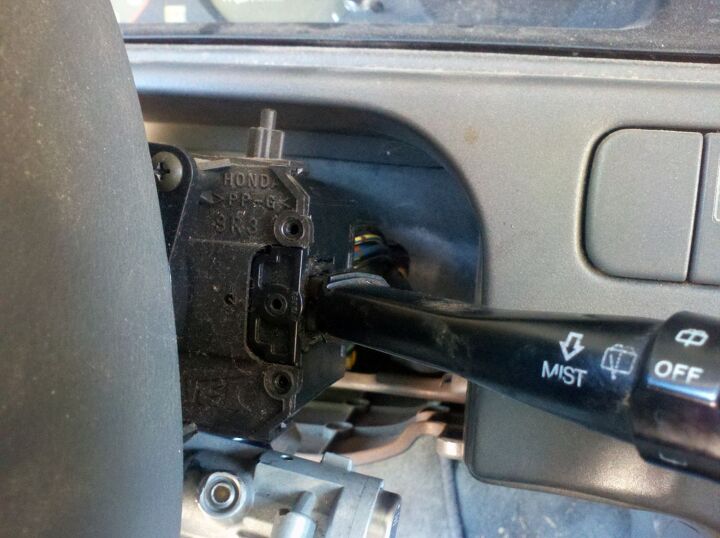Would-Be Civic Thief Thwarted By Hidden Kill Switch, $21 In Junkyard Parts Fixes Damage

Having spent most of my driving years in car-theft-prone neighborhoods in California and preferring the please-steal-me Honda Civic as my daily driver of choice, I learned many years ago that a secret starter and/or fuel-pump cutoff switch is a must-have. Such kill switches have prevented theft of my past Civics on three occasions that I know about. Last week, the maddeningly hard-to-find kill switch I installed in my 18.2-second quarter-miler 1992 Civic left a Denver Honda thief empty-handed.
I’m not going to give away the type and location of the kill switch in my ’92, other than to say that it cuts power to both the starter solenoid and the fuel pump and it doesn’t look like an electrical switch. The first Civic kill switch I installed (in an ’85 hatchback that was stolen out of the Oakland Coliseum parking lot and then recovered a couple months later when other thieves stole its license plates while parked near 98th and Edes, attracting police attention) was pretty crude: a spring-type clothespin ziptied into the underdash wiring harness, with electrical contacts in the jaws; I would stick a guitar pick between its jaws to interrupt the power to the starter circuit and remove the pick to enable starting— crude but effective, and just about impossible to identify at a glance. My current setup is much more sophisticated as well as more invisible; the thief used a key to get into the car and turn the ignition switch (Hondas of the 1980s and early 1990s had a depressingly small number of possible key configurations, so a thief need only carry a few dozen in order to have a good chance of starting any random Honda of the era; try your Honda key on junkyard car locks to see what I mean), but the starter wouldn’t crank for him. So, he removed the steering-column cover— busting the wiper switch in the process— and tried to jump wires to fire the starter. No dice. On to the next 1992-95 Civic!
Nothing other than the wiper switch was broken and nothing was stolen from the car (not even my snazzy five-cell red-anodized MagLite), so I got off light. Still, I needed wipers, so off came the shattered switch. Next stop: junkyard!
The fifth-generation Civic has become something like the ’55 Chevy of the 21st Century, with huge demand for parts (no doubt the motivation behind the scrote who tried to steal mine). This means that they’re quite rare in self-service junkyards. I found this switch in good condition on a junked ’94, but there was a problem.
My car, a one-notch-up-from-the-bottom DX model, has a rear wiper/washer, and this CX does not. The switch would physically bolt up, but the rear wiper couldn’t be actuated. The lever on my car’s switch was pretty well busted, so I couldn’t buy this switch and swap levers. Sorry about the blurry cell-phone photos here; I was in such a hurry to fix the car that I forgot to grab a real camera.
The only other 1992-95 Civic at the yard was a ’93 hatch that had had its interior completely torn apart. It did have the correct wiper switch (buried beneath greasy suspension parts on the back seat), but its case was cracked and internal components were missing.
Still, I had enough components between the two junkyard switches, plus the one from my car, to make one good one.
The lever and wiring harness from the broken ’93 switch joined the guts of the ’94 switch. I had to swap the grease-coated electrical-contact sliders to make the lever actuators work correctly, but such is the nature of finicky automotive electrical components.
Honda was thoughtful enough to enable wiper switch replacement with the steering wheel installed (in stark contrast to many Detroit cars, which tend to be all about ease/cheapness of initial assembly, to hell with everything else), so installing the Frankensteined wiper switch was a three-minute task.
All fixed! I’m sure glad the thief didn’t have a tow truck.

Murilee Martin is the pen name of Phil Greden, a writer who has lived in Minnesota, California, Georgia and (now) Colorado. He has toiled at copywriting, technical writing, junkmail writing, fiction writing and now automotive writing. He has owned many terrible vehicles and some good ones. He spends a great deal of time in self-service junkyards. These days, he writes for publications including Autoweek, Autoblog, Hagerty, The Truth About Cars and Capital One.
More by Murilee Martin
Latest Car Reviews
Read moreLatest Product Reviews
Read moreRecent Comments
- Corey Lewis It's not competitive against others in the class, as my review discussed. https://www.thetruthaboutcars.com/cars/chevrolet/rental-review-the-2023-chevrolet-malibu-last-domestic-midsize-standing-44502760
- Turbo Is Black Magic My wife had one of these back in 06, did a ton of work to it… supercharger, full exhaust, full suspension.. it was a blast to drive even though it was still hilariously slow. Great for drive in nights, open the hatch fold the seats flat and just relax.Also this thing is a great example of how far we have come in crash safety even since just 2005… go look at these old crash tests now and I cringe at what a modern electric tank would do to this thing.
- MaintenanceCosts Whenever the topic of the xB comes up…Me: "The style is fun. The combination of the box shape and the aggressive detailing is very JDM."Wife: "Those are ghetto."Me: "They're smaller than a Corolla outside and have the space of a RAV4 inside."Wife: "Those are ghetto."Me: "They're kind of fun to drive with a stick."Wife: "Those are ghetto."It's one of a few cars (including its fellow box, the Ford Flex) on which we will just never see eye to eye.
- Oberkanone The alternative is a more expensive SUV. Yes, it will be missed.
- Ajla I did like this one.















































Comments
Join the conversation
I protected a red VW Gol GTS in the streets of Rio from 1988 until 1993 with a kill switch wired to the left driver air vent. It was professionally installed by a Hungarian cold-war refugee that did very-high-voltage electric fences for industrial storage lots alongside Avenida Brasil in Rio. That man was a craftsman. Vent turned to the left position (facing window) car would run. Vent turned all the way to the right, car would run. But if ignition was interruped (you parked the car) battery would act as if it was 1/2 dead. The crank would turn slow for 4 seconds or so and stop as if battery was a goner. I do not know how that was accomplished. You could do this for as many times as you wanted. Once you moved the vent to the left, it would start. Furthermore, every time driver's door was opened with engine running (for car jacking) engine would run for 3 minutes and stop. Then the battery would do its thing. The only drawback is it could not be deactivated. It made it for a nightmare at restaurants and the like.
You should try changing the wiper switch on a '78 MG Midget sometime. It's both simple and utterly ridiculous and complicated at the same time. You only have to remove 5 bolts to get to the switch but they are the bolts that hold the steering column into the car! Once the column is out it takes only a couple of minutes to replace the switch so the whole job only takes 15 minutes so I could not complain but it's a typical BL solution, right up there with the components that are bolted to the firewall with a bolt and a non-captive nut, what the hell were they thinking?